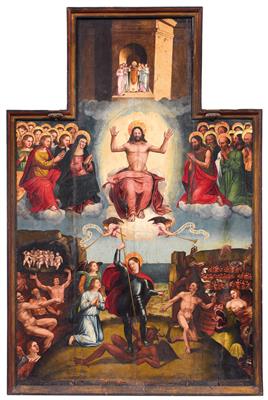Spanish School, early 16th Century

The Last Judgment,
oil on panel, shaped top, 233 x 152 cm, framed
The panel support of the present painting, a depiction of the Last Judgement, has a shaped rectangular top that is reminiscent of Rogier van der Weyden’s Deposition (Madrid, Museo del Prado). In terms of motifs, the picture reveals the painter’s familiarity with Italian Renaissance painting, particularly with Raphael’s Transfiguration of Christ in the collection of the Vatican and with Michelangelo’s ceiling frescoes in the Sistine Chapel. The painting style, on the other hand, is less characteristic of an Italian artist and rather suggests that the painter was trained in the Netherlands; however a Hispano-Flemish artist cannot be excluded.
The panel’s iconography is unusual. In line with tradition, the lower section of the composition depicts hell, however, the left side does not show the entry of the blessed into Paradise, but Limbo, with the infants who have not been baptized at the top (Limbo of Infants or limbus puerorum) and Adam and Eve at the bottom. The entrance to heavenly Jerusalem does not, as usual, appear on the left side, but on the central axis, above the Supreme Judge of the World presenting his stigmata.
Technical analysis:
The complex scene was carefully drawn with fluid lines before painting, as IR reflectography demonstrates. The under drawing is made with a thin brush and black carbon ink, not only for the contours and shapes of the figures, but also to indicate the development of some folds and some shadows, with a peculiar hatching sometimes crossed, which can be clearly seen on Christ’s body and red cloak or under Saint John, for example. A few minor changes can be noticed, the position of the Christ’s feet.
Among pigments, reflectance measures indicate the use of azurite in all the blue areas, verdigris in the greens, lead-tin yellow (“giallorino”) in the light or pale yellows (i.e. in the light behind Christ), and yellow ochre in the darker yellows. Vermilion constitutes the brighter reds and a carmine type red lake makes up the other kind of red in the garments. Brown earth is mixed with vermillion in the darker browns, flesh tones are made with traditional mixtures of lead white with parts of vermilion and ochre.
We are grateful to Gianluca Poldi for the technical analysis.
17.10.2017 - 18:00
- Dosažená cena: **
-
EUR 50.000,-
- Odhadní cena:
-
EUR 40.000,- do EUR 60.000,-
Spanish School, early 16th Century
The Last Judgment,
oil on panel, shaped top, 233 x 152 cm, framed
The panel support of the present painting, a depiction of the Last Judgement, has a shaped rectangular top that is reminiscent of Rogier van der Weyden’s Deposition (Madrid, Museo del Prado). In terms of motifs, the picture reveals the painter’s familiarity with Italian Renaissance painting, particularly with Raphael’s Transfiguration of Christ in the collection of the Vatican and with Michelangelo’s ceiling frescoes in the Sistine Chapel. The painting style, on the other hand, is less characteristic of an Italian artist and rather suggests that the painter was trained in the Netherlands; however a Hispano-Flemish artist cannot be excluded.
The panel’s iconography is unusual. In line with tradition, the lower section of the composition depicts hell, however, the left side does not show the entry of the blessed into Paradise, but Limbo, with the infants who have not been baptized at the top (Limbo of Infants or limbus puerorum) and Adam and Eve at the bottom. The entrance to heavenly Jerusalem does not, as usual, appear on the left side, but on the central axis, above the Supreme Judge of the World presenting his stigmata.
Technical analysis:
The complex scene was carefully drawn with fluid lines before painting, as IR reflectography demonstrates. The under drawing is made with a thin brush and black carbon ink, not only for the contours and shapes of the figures, but also to indicate the development of some folds and some shadows, with a peculiar hatching sometimes crossed, which can be clearly seen on Christ’s body and red cloak or under Saint John, for example. A few minor changes can be noticed, the position of the Christ’s feet.
Among pigments, reflectance measures indicate the use of azurite in all the blue areas, verdigris in the greens, lead-tin yellow (“giallorino”) in the light or pale yellows (i.e. in the light behind Christ), and yellow ochre in the darker yellows. Vermilion constitutes the brighter reds and a carmine type red lake makes up the other kind of red in the garments. Brown earth is mixed with vermillion in the darker browns, flesh tones are made with traditional mixtures of lead white with parts of vermilion and ochre.
We are grateful to Gianluca Poldi for the technical analysis.
|
Horká linka kupujících
Po-Pá: 10.00 - 17.00
old.masters@dorotheum.at +43 1 515 60 403 |
| Aukce: | Obrazy starých mistrů |
| Typ aukce: | Salónní aukce |
| Datum: | 17.10.2017 - 18:00 |
| Místo konání aukce: | Wien | Palais Dorotheum |
| Prohlídka: | 07.10. - 17.10.2017 |
** Kupní cena vč. poplatku kupujícího a DPH
Není již možné podávat příkazy ke koupi přes internet. Aukce se právě připravuje resp. byla již uskutečněna.
